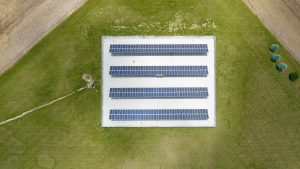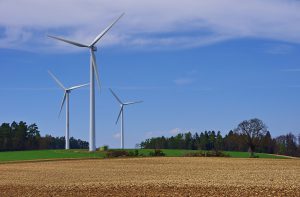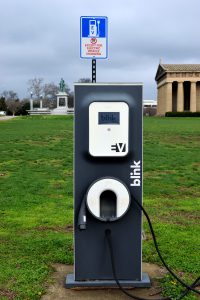By Pat Keegan and Brad Thiessen
The decisions about how to heat your home and how to fuel your transportation needs are among the most important environmental decisions you can make. There are a number of changes happening in the energy sector — electric co-ops in particular — that are making your electricity cleaner.

Electric co-ops have pioneered community solar programs, where members subscribe to a community project and the co-op installs a large array that is much less costly per kilowatt than smaller rooftop projects. Image Credit: Dan Husted (Lake Region Electric Cooperative).
Decades ago, coal was the preferred fuel for electricity generation. As investments in environmental upgrades took hold, the energy industry increased the use of low sulfur coal and found ways to clean the coal and burn it more efficiently. Scrubbers were installed in coal plants to reduce sulfur emissions, but even after these improvements were made, natural gas turbines were still considered environmentally preferable to coal plants. In 1990, utilities depended upon coal to generate more than half of their electricity, but by 2016 that dropped to less than one third.

Improvements in the technology and state sponsored renewable energy requirements have encouraged the development of wind generation.
In recent years, solar and wind generation have taken off and now provide more than 8 percent of utility energy generation. Electric co-ops have installed solar at a record pace, with solar capacity growing more than four times since 2015. Electric co-ops pioneered community solar programs where members subscribe to a community project and the co-op installs a large array that is much less costly per kilowatt than smaller rooftop projects. Nearly 200 co-ops offered community solar programs in 2017, and more than 500 co-ops across the country use electricity generated by wind power.
These statistics are national, but the environmental impacts of electricity depend upon where you live and where your electric co-op purchases electricity. Many co-ops publish this information on their website or in their annual reports on the sources of electric generation. Some include information on carbon emissions.
With all that in the back of your mind, think about decisions you might be looking into, such as home heating and vehicle purchase.
Heat pumps are about 1.5 times more efficient than they were in the 1970s, and they’re functioning better in colder temperatures. Heat pumps take care of your cooling needs as well and do so with about half the energy they required in 1990. The best choice for home heating and cooling depends to a large degree on the climate where you live. In more extreme climates, you need more heating or cooling capacity and can justify splurging for the more energy efficient models.
As our energy supply becomes cleaner, electric vehicles are becoming a better environmental choice across the country. The environmental advantage depends upon how electricity is generated in different locations, and there are other factors to consider when looking at an electric vehicle. The fuel cost of an electric vehicle is, on average, half as much per mile as a gasoline vehicle. Electric vehicles generally require less maintenance, but the batteries eventually need to be replaced. Battery costs are dropping, but potential buyers should note this will still be a hefty bill. Electric vehicles cost more upfront than their gas counterparts, but the cost is coming down with every new model.
Your choice in heating system and vehicle are good places to start if you’re looking to make environmental-based changes to your lifestyle, but remember the other things you can do to reduce the environmental impact of your energy use. Insulate and seal the air leaks in your home. Set the thermostat a little lower in the winter and a little higher in the summer. You can also check with your local electric co-op to see if they offer a community solar program or additional energy-saving tips.
This column was co-written by Pat Keegan and Brad Thiessen of Collaborative Efficiency.


